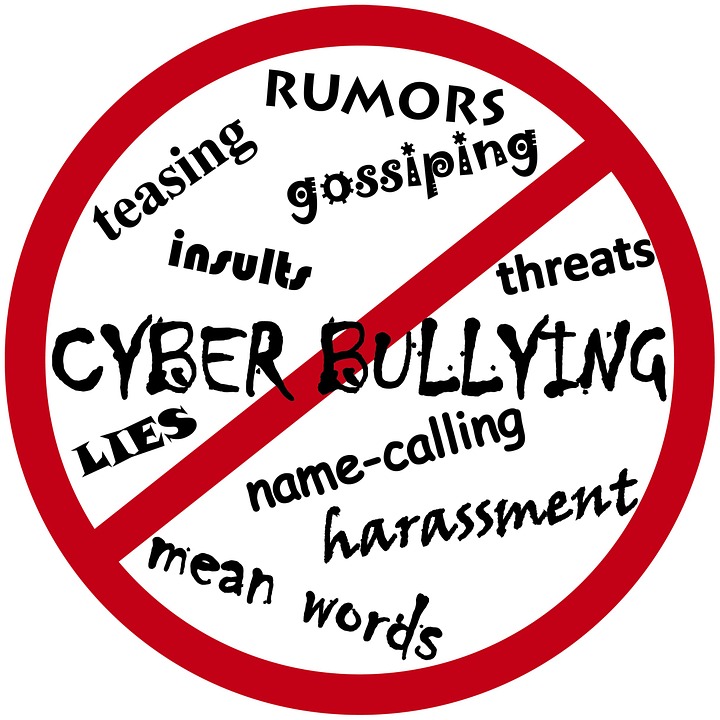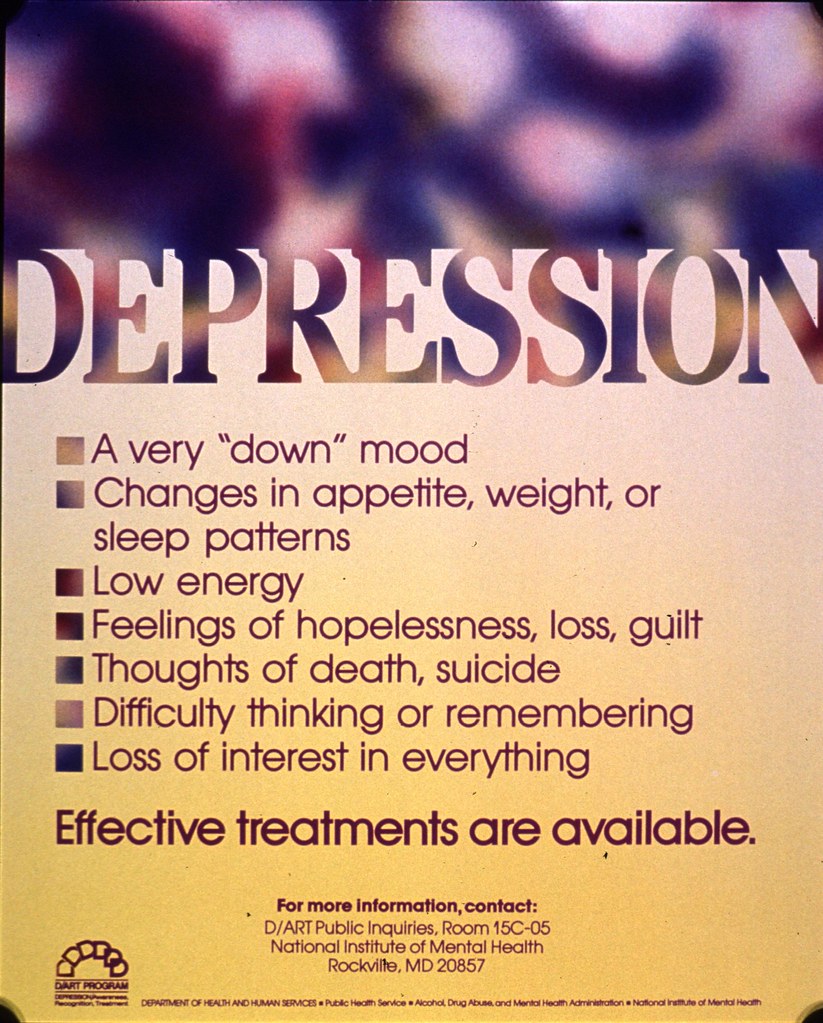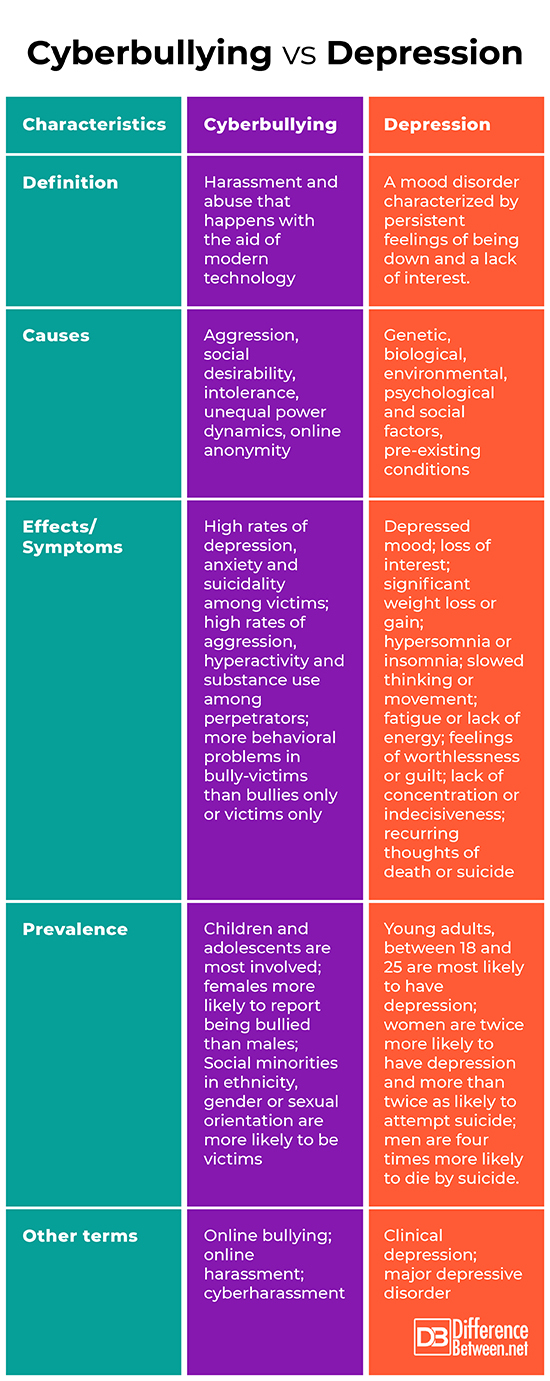Difference Between Cyberbullying and Depression
• Categorized under Psychology,Science | Difference Between Cyberbullying and Depression
Cyberbullying and depression are two problems that can be called modern, having come into focus and discussion only in the 21st century. At first glance, these two phenomena don’t quite have anything to do with each other, except maybe that cyberbullying may trigger depression. But for today’s parents, it may be difficult to tell whether their child is a victim of a special type of bullying or going through depression. This situation is especially true during the teenage years, a curious time when children are most reluctant to share details of their daily lives with their parents. Although unrelated, both are equally common and equally serious situations that need to be handled carefully.
The natures of these two phenomena are very different. Cyberbullying is a social phenomenon while depression is more of a personal situation, although it interacts with social factors. In some places, cyberbullying has been elevated to a crime, punishable by law. Anywhere in the world, depression is a mental illness, a medical diagnosis of the psychiatric kind. Cyberbullying and depression are discussed and differentiated further in the succeeding sections.
What is Cyberbullying?
Cyberbullying is not simply bullying that happens in cyberspace. Bullying, on its own, is already difficult to define; add cyber to that and it becomes more. Harassment is a term that is constantly thrown in, and abuse is used for the more serious and persistent attacks. Online gaming, phone calls and text messaging are added into the mix of platforms where the bullying happens, while similar terms such as online bullying, online harassment and cyberharassment are also used. One can attempt to define cyberbullying by stating that it is harassment and abuse that happens with the aid of modern technology.
Research through focus groups say that cyberbullying is caused by the same things as the schoolplace variety, citing the same social causes such as aggression, social desirability, intolerance and unequal power dynamics, albeit of a different kind. The anonymity of the internet also increases the likelihood of bullying. Cyberbullying is usually more vicious than traditional bullying and its online nature denies the victim the sense of respite or safety that they usually get at home. As a result, the effects of bullying are magnified. Compared to traditional bullying, cybervictims have higher rates of depression, anxiety and suicide risk, while cyberbullies have higher rates of aggression, hyperactivity and substance use. Bully-victims, those who shift from being the victim to being the bully or vice versa, also exhibit more behavioral problems.
Just as in traditional bullying, children and adolescents are the most involved in cyberbullying, as both bully and victim. Females are more likely to be victims, or at least are more likely to report bullying, than males. Out of ignorance or intolerance, those who are considered different are commonly the victims, such as ethnic minorities, gays, lesbians, bisexuals or transgender people.
What is Depression?
Depression, also called clinical depression and major depressive disorder, is a mood disorder characterized mainly by persistent feelings of being down and a loss of interest. It is not simply the feeling of sadness or melancholy, as depression typically lasts for weeks or months, sometimes even years, with various symptoms occurring all throughout the illness.
It is still unclear what causes depression exactly. However, medical professionals at least agree on the various factors that all combine to make an individual more likely to become depressed with any given possible trigger. These most likely factors are genetic, biological (changes in the brain’s neurotransmitter levels and the body’s hormones), environmental (amount of sunlight, temperature, etc.) psychological and social factors, as well as pre-existing conditions such as bipolar disorder. The American Psychiatric Association, the leading authority on psychiatric illnesses, lists the symptoms of depression, requiring at least five of the symptoms to be present for at least two weeks for diagnosis to be made. The symptoms include: depressed mood, loss of interest, significant weight loss or gain, hypersomnia or insomnia, slowed thinking or movement, fatigue or lack of energy, feelings of worthlessness or guilt, lack of concentration or indecisiveness, and recurring thoughts of death or suicide.
Although depression may happen to anyone at any age, young adults, between the ages of 18 and 25 are most likely to have depression than any other age group. Women are twice more likely to have depression than men, and more than twice as likely to attempt suicide as men. However, perhaps because they are generally more aggressive and use more lethal means, men are four times more likely to die by suicide than women.
Difference between Cyberbullying and Depression
Definition
Cyberbullying is harassment and abuse that happens with the aid of modern technology. Depression is a mood disorder characterized by persistent feelings of being down and a lack of interest.
Causes
Cyberbullying may be caused by aggression, social desirability, intolerance and unequal power dynamics as well as online anonymity. Depression may be caused by a combination of genetic, biological, environmental, psychological and social factors, as well as pre-existing conditions such as bipolar disorder.
Effects/Symptoms
Cyberbullying may cause high rates of depression, anxiety and suicidality among its victims and high rates of aggression, hyperactivity and substance use among its perpetrators; bully-victims display more behavioral problems than bullies only or victims only. Symptoms of depression include depressed mood, lack of interest, significant weight loss or gain, and hypersomnia or insomnia, among others.
Prevalence
Children and adolescents are most involved in cyberbullying, with females more likely to report being bullied than males. Social minorities in ethnicity, gender or sexual orientation are more likely to be victims as well. Young adults, between 18 and 25 are most likely to have depression. Women are twice more likely to have depression than men, and more than twice as likely to attempt suicide, with men being four times more likely to die by suicide.
Other terms
Other terms used similarly with cyberbullying include online bullying, online harassment and cyberharassment. Other terms for depression are clinical depression and major depressive disorder.
Cyberbullying vs Depression
Summary
- Cyberbullying and depression are two common modern problems, having come into focus and wide discussion only in the 21st century.
- Although very different, the effects or symptoms of both cyberbullying and depression in a child may be difficult for a parent to determine and differentiate, especially in teenagers as they are more prone to keep secrets from their parents.
- Cyberbullying is not simple bullying as the attacks tend to be more vicious and the effects are magnified in both bully and victim due to the anonymity of being online and the loss of the sense of respite and safety afforded by being at home.
- Depression is not simply feeling down or sad as it usually lasts for weeks or months and does not go away without some form of intervention.
- Difference Between Hematoma and Melanoma - February 9, 2023
- Difference Between Bruising and Necrosis - February 8, 2023
- Difference Between Brain Hematoma and Brain Hemorrhage - February 8, 2023
Sharing is caring!
Search DifferenceBetween.net :
Cite
APA 7
Brown, g. (2020, July 14). Difference Between Cyberbullying and Depression. Difference Between Similar Terms and Objects. http://www.differencebetween.net/science/difference-between-cyberbullying-and-depression/.
MLA 8
Brown, gene. "Difference Between Cyberbullying and Depression." Difference Between Similar Terms and Objects, 14 July, 2020, http://www.differencebetween.net/science/difference-between-cyberbullying-and-depression/.
Leave a Response
Written by : gene Brown. and updated on 2020, July 14
References :
[0]Image credit: https://live.staticflickr.com/1909/30268839457_71353d4956_b.jpg
[1]Image credit: https://commons.wikimedia.org/wiki/File:Cyber-bullying-122156_960_720.jpg
[2]Aboujaoude, Elias. "Cyberbullying: From the Playground to "Insta"." Psychology Today. January 11, 2015. https://www.psychologytoday.com/us/blog/compulsive-acts/201501/cyberbullying (accessed February 8, 2020).
[3]Entwistle, Kirsty. "Cyberbullying from a Psychological Perspective." Medium. May 13, 2019. https://medium.com/@kirstyentwistle/cyberbullying-from-a-psychological-perspective-6e892ce63b37 (accessed February 8, 2020).
[4]Goldman, Laura. "What is depression and what can I do about it?" MedicalNewsToday. November 22, 2019. https://www.medicalnewstoday.com/articles/8933.php (accessed February 8, 2020).
[5]Lenhart, Amanda. "Cyberbullying." Pew Research Center. June 27, 2007. https://www.pewresearch.org/internet/2007/06/27/cyberbullying/ (accessed February 8, 2020).
See more about : Cyberbullying, depression



